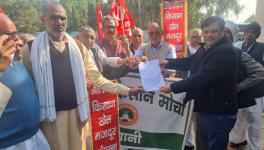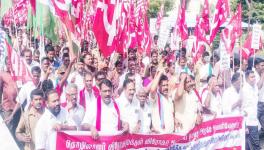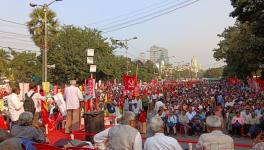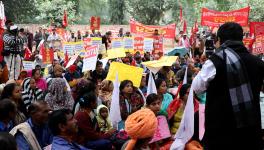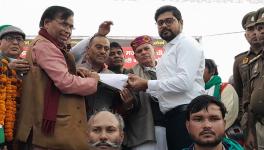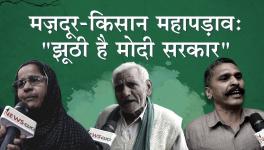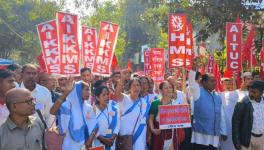2017: A Year of Resistance
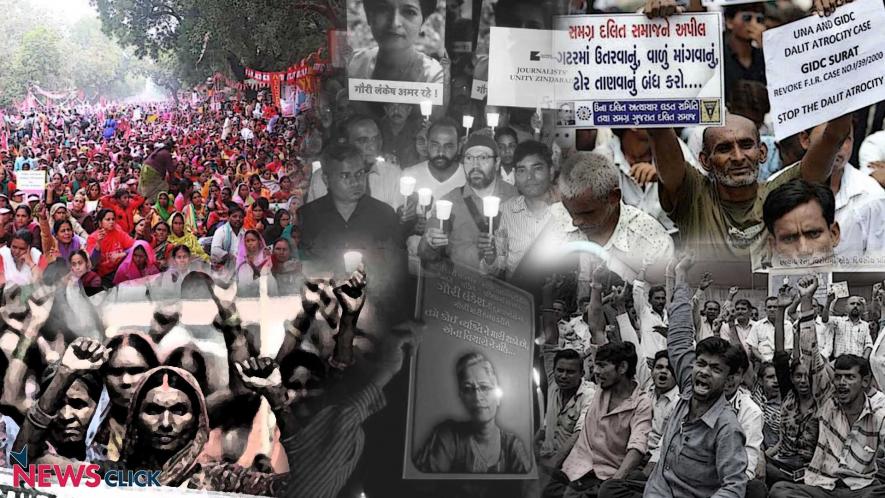
Newsclick Image by Sumit
2017 was the year of increasingly diverse, yet more united struggles by working people of all sorts in India. In dozens of public sector units – ports, steel plants, coal mines, ordnance factories, banks, insurance companies, etc. – workers went on strikes or protested against relentless govt. pressure to privatise national assets by handing them over to private industrialists. Contract workers and ‘scheme workers’ (those employed in govt. schemes) saw large scale protests, often confronting police attacks in various states. Unorganised sector workers like those in the road transport sector fought against proposed laws to squeeze out small units and privatise public services. And in industrial areas from the north-east to Gujarat and from Himachal Pradesh to Tamil Nadu, workers braved attacks from police and hired goons to fight for their livelihoods.
This increased tempo of struggling workers was matched by a continuing swell of farmers’ movements, somewhere facing police bullets (Mandsaur, MP) and at other places forcing the authorities to bow to their demands (Rajasthan).
Diverse strands of struggles were brought together in two major protests held in the capital Delhi in November. One was the historic 3-day ‘maha-padav’ (mass sit in) in which about 2 lakh workers participated, pressing the govt. to accept their long pending demands which include, minimum wage of Rs.18,000, end to contractor-raj and privatization, control of prices and strengthening of PDS, withdrawal of neo-liberal labour law reforms, etc. The other, also in November, saw a 2-day ‘Kisan Mukti Sansad’ (farmers’ liberation parliament) in which over 1 lakh farmers congregated at Delhi, including families of farmers that had committed suicide due to debt and losses.
So, 2017 became not only a year of deep ferment among India’s working people, it also saw increasing intertwining of two biggest classes of Indian society – workers and peasants. This was repeatedly seen in several struggles. Trade unions held protests across the country on 16 June after five farmers were killed in a brutal police attack on protesting farmers in Mandsaur. Workers participated in large numbers in protests organized in 150 districts on 9 August by the Bhoomi Adhikar Andolan, a joint platform of peasant and other organizations. Workers also joined the massive kisan mukti yatras that covered over 10,000 kms mobilizing farmers.
Farmers’ Struggles
2017 could well be the year of the struggling farming. High indebtedness, often leading to suicides, inability to meet even cost of production due to unremunerative prices, land acquisitions, low agricultural wages all contributed to ever deepening agrarian crisis that burst out in angry protests in MP, Maharashtra, Karnataka, UP, Rajasthan, Tamil Nadu and other states. In most places, it was met with strong arm methods by govts. but such was the pressure that almost all state govts. were forced to announce debt waivers. The most significant victory was in Rajasthan where the govt. was forced to concede various demands after a massive movement.
All these struggles were woven together through a kisan mukti yatra that travelled across the country mobilizing farmers for increased struggles, ultimately converging at the Delhi ‘Kisan Mukti Sansad’.
Workers’ Struggles
One of the significant features of workers’ struggles in 2017 was the high participation of women. This was mainly because women dominated scheme workers fought a bitter and arduous battle against govt. fund cuts and refusal to treat them as regular employees. There are about 1 crore scheme workers in the country, employed on irregular or contract basis, though they work year round delivering services like primary healthcare, meals in schools, child care and nutrition, etc. During 2017 scheme workers held protest actions in Maharashtra, Assam, Kerala, AP, Uttarakhand, Karnataka, Haryana, Punjab, Jharkhand, Bihar, Odisha, Himachal Pradesh, Gujarat, Assam, among others. They also successfully held a one day country-wide strike on 20 January 2016 which was preceded by demonstrations in practically all districts. Later in the year, on 21 August, ASHA workers (health workers) held a massive protest at the Parliament, submitting nearly 50 lakh signatures from villagers from all over the country in support of their demands.
Another major strand of struggles was against Modi govt.’s privatization drive. In its three and a half year reign, Modi’s so called nationalist govt. has sold of Rs.1.25 lakh crore worth of public sector assets to private buyers, putting at risk thousands of jobs. Protests against these moves spread through workers in public sectors throughout the country. Defense production employees held a 45 day relay hunger strike in July. In Tamil Nadu, Kamrajar Port employees protested against sale of the profit making port to Adani Group, reportedly a crony of Modi. Bharat Earth Movers Ltd employees went on strike in May in Kolar and Mysore districts of Karnataka and Palakkad district (Kerala) against disinvestment. In March, Cochin shipyard workers went on strike against 25% privatization. In April, workers went on strike in three steel plants (Durgapur, Salem and Bhadrawati) which were up for sale. Dredging Corp. workers also struck work in April. In Haryana, state road transport workers went on a lightning strike against plan to handover routes to private operators. There were huge protests in coal mines against closure of 10 ECL mines in West Bengal. NALCO workers in Odisha protested against privatization. On 28 February, bank employees across the country held a one day strike against govt. plans of privatization.
Even government employees, both central and state, were on the warpath against govt. delays in implementing pay commission recommendations and changes in pension plans. Over 13 lakh central govt. employees went on strike on 16 March while on 2 March state govt employees’ held a mass dharna at Delhi demanding withdrawal of a new pension scheme, against out-sourcing of work and other demands. Municipal workers in AP, Karnataka and Tamil Nadu held protests and strikes against similar outsourcing of jobs to private contractors. In Karnataka, even gram panchayat workers protested against similar issues.
Road transport workers in various parts of the country struggled against the proposed new law for privatization, including in Tamil Nadu, Kerala, W.Bengal, Bihar, Odisha, Assam, Karnataka, etc. Construction workers, mostly in the unorganized sector protested against low wages, job losses and repression in various states including Haryana, W.Bengal etc. A countrywide strike by medical sales representatives was held in February demanding cost based capping of medicine, nil tax and regulation of working conditions in MNCs. Workers from 300 tea gardens in W.Bengal went on a 2-day strike demanding better wages. They had to face police brutality. In Tamil Nadu, fishermen held protests against a govt. law prohibiting them from going beyond three nautical miles out in the sea. Beedi workers in several states protested against low wages. Even LIC agents held a protest rally in Delhi in August against govt. policy regarding the insurance sector.
In many states, like Karnataka, W.Bengal, Tamil Nadu, Rajasthan, Assam etc. huge protests were held by joint platforms of trade unions and other organizations against price rise, farmers’ debts, job losses and other people’s issues.
As the year ends, the foundation laid by these struggles – and many others not mentioned – will become a launching pad for widening struggles in the coming months. Ultimately, the aim is to reverse the anti-people policies followed by this and previous govts. and install a pro-people dispensation with an alternative set of policies.
Get the latest reports & analysis with people's perspective on Protests, movements & deep analytical videos, discussions of the current affairs in your Telegram app. Subscribe to NewsClick's Telegram channel & get Real-Time updates on stories, as they get published on our website.











